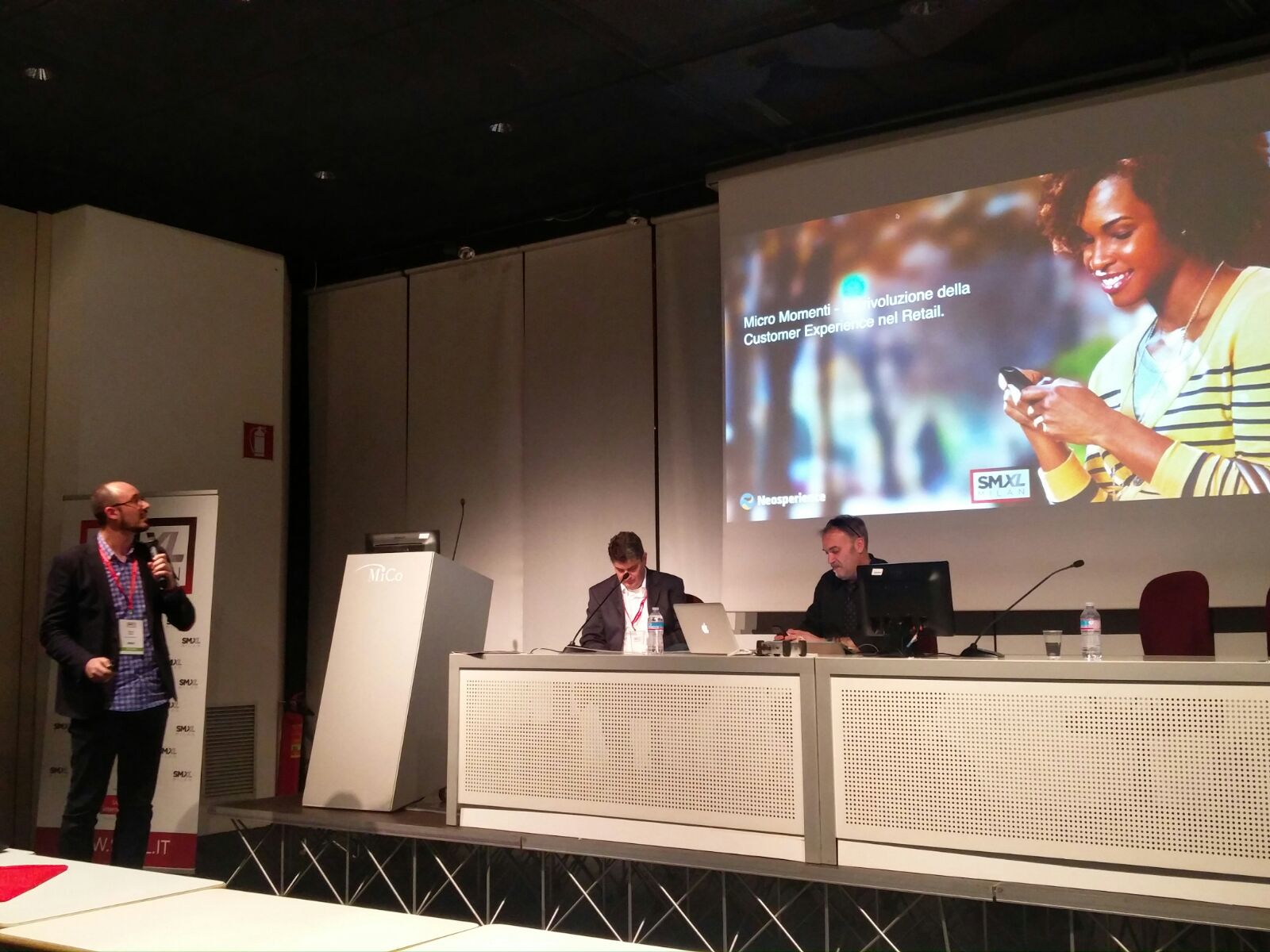
What is the first thing you do when you wake up and the last before you sleep? Behind this (apparently futile) question we can find the fate of the retail customer experience.
We tried to find proper answers during Neosperience's speech at the SMXL 2016 conference, a three-days long tour de force of discussions about digital and mobile marketing.
The Micro Moments, as canonized by Google, have been the starting point of the panel, not surprisingly entitled "Riding The Micro Moments Wave".
The awareness that the rhythm of our existence is marked by the mobile revolution is certified by three stats:
15 - The minutes between when we wake up and when we turn on the smartphone.
150 - How many times we check, on average, the smartphone during the day.
177 - The minutes we spend, on average, every day looking at the screen of a mobile device.
Linking these statistics together, we can highlight that customers today do not go online … they live online. Better yet, they experience an endless sequence of moments, in a nonlinear balance between the online and offline worlds.
The consumption habits - of contents and products - have deeply changed in a competitive environment where the customers face an information overload. The smartphone has become the first screen, the reference for our daily activities; this leads to a complete revision of :
How we search the contents - Each day on Google there are 3.5 billion searches. 60% of these now comes from mobile.
How we communicate with the brands - In the developed markets, we spend more time using apps than watching television.
How we choose and buy the products - Nearly 60% of customers starts shopping on a device and continues or ends on another device or in-store.
We are witnessing the customer journey revolution. Your brand must learn to seize the moment and engage customers right in the moment of truth, because the attention span is falling down (8 seconds), and time becomes the scarcest (and most valuable) resource.
The speed of the mobile revolution can be harsh for those companies that still follow the rigid patterns of traditional marketing. Where there is a danger, however, there is always also an opportunity: by 2020, there will be over six billion mobile users worldwide.
It is not that the 4 Ps of marketing (Product, Price, Place, Promotion) will become useless, but they must be rewritten to acquire new relevance in the digital global markets. The social and economic model promoted by the spread of mobile technology, in fact, shows unique features:
INCLUSIVE
It potentially grants to everyone the access to knowledge, cultural and financial resources (for example, Coursera, Kickstarter and Duolingo).
COLLABORATIVE
It favors an approach of team working among people who are physically away and that connect through your smartphone screen (Qurami, Waze, Quora).
INTELLIGENT
It encourages a more intelligent management of the resources, and allows you to continually reinvent your personal and professional existence (Uber, Airbnb, Mint).

Today, the retail companies can take advantage of an increasing set of technologies that was simply unthinkable just ten years ago: digital signage, mobile apps, the Internet of Things, virtual and augmented reality, beacons, machine learning, artificial intelligence, chatbot, smart analytics.
The problem, then, becomes how to make sense of the technology, starting from the centrality of the customer experience, and without betraying the brand identity (based on the archetypes, and a granular and layered storytelling).
The winning model of the most successful companies is based on awareness that digital customers do not just want to buy a product, they want to live fulfilling experiences.
Brands like Netflix, Spotify, Amazon, Starbucks, Nike remind us that the tipping point to reach the personalization and relevance is to recognize the uniqueness of the client and his journey.
Needless to say, today a retail strategy that is not mobile-first is simply unthinkable. This does not mean, however, that the mobile devices will lead to the death of the physical store.
If it is true that over the past 5 years the in-store traffic has decreased by 57%, it is equally true that the value of every single visit has almost tripled.
When added to an omnichannel strategy, and used as a proxy of the customer, the mobile helps retailers to meet the demand of "What I Want, When I Want, Where I Want it".
Analyzed in this perspective, the smartphone becomes:
A new access door to the physical store.
'Near me' searches have doubled in less than a year. 76% of users that looks for local information on the smartphone then visits the physical store within 24 hours. 28% of these visits turns into a sale.
A new - and privileged - in-store advisor:
91% of customers turns to the smartphone while in the store, looking for ideas on how to solve a given problem. 82% of customers uses the smartphone to search for further information on something they are about to purchase.
Moving forward, we must answer another critical question: What does it mean to build a retail customer experience in the age of mobile connection?
Google comes in help again with the research about the Micro Moments. To offer memorable experiences to customers, a retail brand must develop and cultivate three qualities:
BE THERE - The ability to show up when and where the customer has a need or desire.
BE USEFUL - The ability to be there with relevant content, and to become a primary reference.
BE QUICK - The ability to think and act fast. The speed is essential across all stages of the customer journey.
In the end, the retail world follows one basic rule:
“It is less important for a shopper to be present in-store than for the store to be present wherever and whenever a shopper needs them.” (Google)
Download The Mobile Engagement Playbook, a collection of relevant insights based on many years of Neosperience's expertise that'll help you to overcome the challenges of the digital transformation and grow your business exponentially.



 Your magnifing glass to deeply understand your users and increase the value of each relatonship.
Your magnifing glass to deeply understand your users and increase the value of each relatonship. Listen to the voice of your customers deeply to understand what they truly want.
Listen to the voice of your customers deeply to understand what they truly want. The Lead Generation Platform to get leads from anonymous traffic on your website.
The Lead Generation Platform to get leads from anonymous traffic on your website.  Understand the behavior of people in physical spaces and monitor safety requirements.
Understand the behavior of people in physical spaces and monitor safety requirements. The Digital Commerce Platform designed to follow the most modern technological standards..
The Digital Commerce Platform designed to follow the most modern technological standards.. The XReality platform to tell brand and product stories by connecting physical and digital worlds.
The XReality platform to tell brand and product stories by connecting physical and digital worlds. Points, rewards, levels, badges, missions: a world of nudges to nurture your customer community.
Points, rewards, levels, badges, missions: a world of nudges to nurture your customer community. Discover all the other solutions!
Discover all the other solutions!









